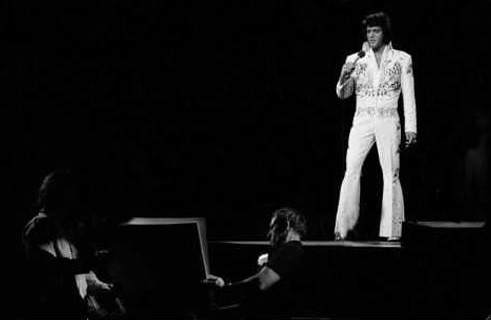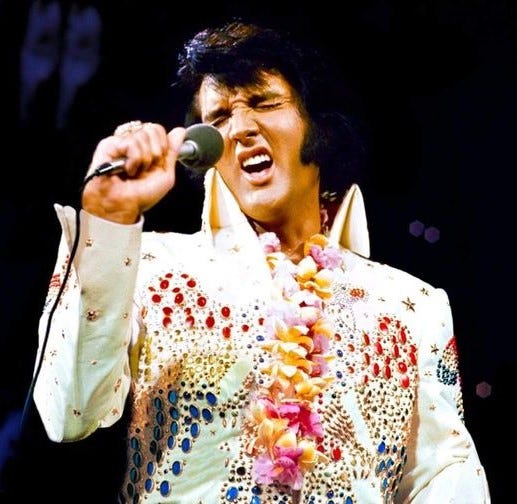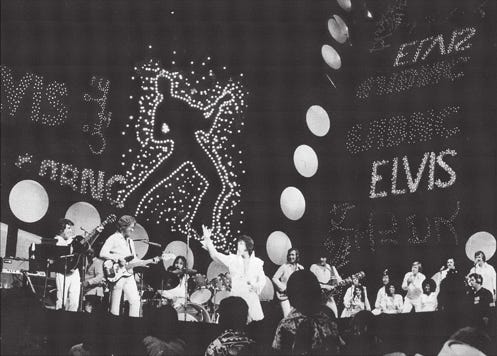DEC4 Podcast Companion: Elvis Aloha From Hawaii - Episode 2 With Gary Wells
The dress rehearsal and the live satellite performance.
Welcome to the companion newsletter for part-two of our three-part DEC4 Podcast series on Elvis Aloha From Hawaii, with Gary Wells (www.soulrideblog.com).
Showtime! The dress rehearsal concert was held at 8.30 pm on January 12, 1973, and was celebrated by noted music writer Dave Marsh as perhaps the finest example of a 1970s Elvis concert ever recorded. It was taped as a fallback in the event of a broadcast malfunction which, as we’ve learned, was a very real possibility right up until the last moment.
But it was a rehearsal after all, and it was a little rough around the edges, with stumbles over lyrics and a number of things to be fine-tuned. Elvis decided to have his hair restyled, and for the satellite broadcast there were some minor wardrobe changes as well, with Elvis choosing the slightly snugger fitting version of the eagle suit, and there were brighter and more contrasting colours for the leis and scarves to bring out the best in the jumpsuit for the cameras.
Rehearsals and soundchecks continued beyond the dress-rehearsal performance and extended throughout the following day (January 13th), as Marty Pasetta and his hand-picked crew worked frantically to overcome potentially disastrous technical faults, including interference in the sound, fixed thanks to Don Ho and a truck load of lead sheeting courtesy of the US Navy. As we discussed, Marty Pasetta told the Palm Springs Desert Sun in 2013, that powerlines to the arena had been cut leading up to the show, although this was not clarified as to whether it had been accidental or deliberate. In other sources, the power failure was blamed on overloading by the television broadcast equipment.
The capacity of the Honolulu International Centre was reduced by over 2 000 to accommodate the staging and television studio equipment, allowing an in-person audience of 6 000 for each show. With technical problems resolved in the nick of time, the satellite broadcast began at 12.30 am on January 14th.
This episode of the podcast focuses primarily on the music and the performance. Gary takes us on an in-depth personal journey through some of the musical highlights of the diverse setlist, which had been carefully devised by Elvis, Charlie Hodge and Red West. After a slightly tentative beginning, You Gave Me a Mountain was the point where things really kicked in; from Steamroller Blues to What Now My Love, It’s Over, My Way, the Kui Lee standard I’ll Remember You, American Trilogy and beyond, in a performance described by local reviewer Wayne Harada as a ‘thrilling, compact hour’.
During the band introductions, Elvis’ ever loyal close friend, musical collaborator, vocal coach, harmony singer and uncredited co-producer, Charlie Hodge, was jokingly introduced as a ‘general flunky’, to a global audience. (Of all the times and places!).
Ever one to share the credit, Elvis also thanked Marty Pasetta and his crew, and the arena audience, for the $75 000 raised for the Kui Lee cancer research fund, more details of which we covered in our previous episode and newsletter. He also introduced Jack Lord (Hawaii Five-0), and Gary gives us a little background on how Jack Lord’s invitation to the show came about, and how his friendship with Elvis evolved.
See Gary’s full Jack Lord bio here;
https://soulrideblog.com/2020/05/06/a-leisurely-look-jack-lord/
Perhaps the musical highlight of the show, and even the greatest single ensemble performance of Elvis’ entire career, was the flawless rendition of Mickey Newberry’s American Trilogy, towards the end of the concert.
Here it is, from the Elvis official YouTube channel.
The flute soloist who performed his part so perfectly and was justly rewarded with a great close-up, is Gabe Baltazar Junior, a Korean War veteran, jazz sax player and flautist whose distinguished musical career included several years at NBC where he conceivably encountered Marty Pasetta.
According to his bio at Alchetron;
“…From 1960 to 1965 he gained international recognition as a world class jazz artist with (Stan) Kenton, recording on 17 critically acclaimed LP's to include backing singers such as Nat King Cole, Jean Turner, and Ann Richards…Between 1965 and 1969 he worked extensively in the Los Angeles recording studios, principally for NBC, where he played in the television orchestras for The Pat Boone Show, The Jerry Lewis Show, The Beautiful Phyllis Diller Show, The Tonight Show with Johnny Carson, The Smothers Brothers Show, and The Glen Campbell Goodtime Hour…Baltazar returned home to Hawaii in 1969 to re-join and then become assistant director of the Royal Hawaiian Band... In 1973, Baltazar played sax and flute in the famous Elvis: Aloha from Hawaii satellite broadcast concert and had a close-up flute solo during An American Trilogy (Battle Hymn of the Republic)…”
Link here to the complete biography at Alchetron, where you can also see Gabe Baltazar interviewed and watch him at work.
https://alchetron.com/Gabe-Baltazar
(Post edit: Gabe Baltazar Jnr sadly passed away June 12, 2022, aged 92. Read his obituary at wbgo.org)
After about an hour on stage, the cape and belt shot off into the audience, and the show came to its conclusion with the standard closer, Can’t Help Falling in Love, from the soundtrack to Blue Hawaii and which had been a #2 hit single (Billboard) in 1961.
Once the arena was cleared after the show, Elvis and the band returned to the stage to record a handful of tracks to be included in the expanded domestic television version which would air on NBC in April. It was a consummate display of professionalism and stamina from everyone, on camera and off, and showed what a great rapport and mutual respect had developed between Elvis and Marty Pasetta. Elvis dutifully did retakes as requested, and rose above a number of mistakes, including his own.

Some of the ratings for the satellite concert were in early, and Colonel Parker was on hand to report the stunning success of the show.
From Peter Guralnick’s Careless Love: The Unmaking of Elvis Presley
“…Colonel came in as they were recording Early Morning Rain, the last number, and announced proudly that they had gotten the highest rating ever registered in Japan, with 37.8% of the viewers in a highly competitive six-network market. There was a real sense of jubilation in the air…”
Marty Pasetta told the Palm Springs Desert Sun in 2013;
“…What I was told by NBC and others is that every third person on earth saw that first show when it went out. In Africa and places like that, it played in theatres, they didn’t have television…”
Some other audience figures (as provided by RCA publicity) - 91% of the Philippine population watched, 25% of Hong Kong’s population watched, from where it was also relayed into Macau and China; it reached 70 - 80% of the TV sets in South Korea and, according to Rocco Laginestra (RCA Records President), was also relayed by the Armed Forces Network to South Vietnam. (Bearing in mind the war was ongoing).
Wayne Harada wrote the concert review in the Honolulu Advertiser, which has become something of an official account with lines quoted widely in subsequent publications and biographies. The complete article can be found here (Thanks again to the brilliant elvisconcerts.com);
https://www.elvisconcerts.com/newspapers/press443.htm
Correction:
I must apologize to Miss Ketty Lester who, of course, sang "Love Letters". It was not Kitty Kallen, as I said on this episode. Ketty is alive today, aged 87. (Thanks to Gary for this clarification).
Next Time;
The expanded television special that aired domestically in April, the #1 double album and hit single, and what happened next, including a look at the evolving financial arrangements between Colonel Parker, Elvis and RCA Records.
You can contact us on Facebook or at the DEC4 webpage. We’re also on Tumblr.
Thanks to Steve Collins, tellmewhere2go.com and Gainesville.
Thanks for listening, and reading!














